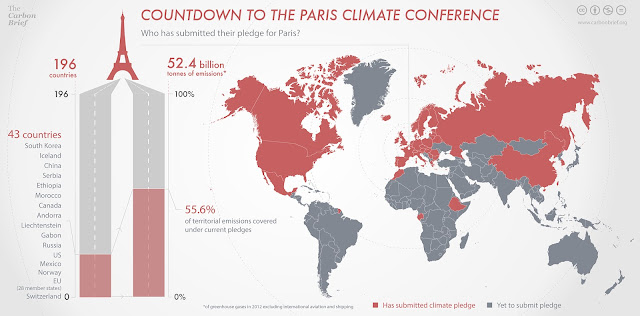Critical analysis of INDC:
Intended Nationally Determined Contributions
Countries across the
world have decided to create a new international climate agreement on a United Nations
Framework on Conventional Climate Change (UNFCCC). There is conference in the end of the year (Dec 2015) in Paris regarding
the same. For this, countries have agreed to announce a public outline of their
actions they will take after 2020 under a new international agreement, known as
their Intended Nationally Determined Contributions (INDCs). The INDCs will determine if the world
is able to come to a common agreement in order to lower carbon emission and
have a climate-resilient future.
The
INDC will consist of countries determining their contributions to reduce
greenhouse gases, taking into account their national priorities, circumstances
and capabilities enough to keep global
temperature rise to 2 degrees Celsius. They will determine an action plan
to reduce greenhouse gases by decreasing their dependency on fossil fuels and
using alternative sources of energy . This will be included in a global
framework to decrease carbon emission and climate-resilient future. It will
create a constructive feedback loop between national and international bodies
so as to benefit the world.
Click here to read: All you need to know about PM Narendra modi's visit to UAE
Also read - Success factors to perform well in AFCAT Exam
Click here to read: All you need to know about PM Narendra modi's visit to UAE
Also read - Success factors to perform well in AFCAT Exam
The
primary aim for the governments will be to submit a report as to how they will decrease
their emissions according to their capabilities and circumstances. Also, they
need to tell how they will adapt to the
climatic changes. Moreover, they can ask for support if needed.
For
developed countries, they need to define
a target of the reductions in carbon emissions by the year 2025-2030. Such pledges will touch
every sector of the economy. Few sectors may be left out by some countries such
as the forestry and land-use sector.
For
developing countries the rules are a bit different. They can plan to have
overall emissions to rise but at a much slower rate so that it doesn’t affect
their economic growth. Another strategy can be to have a renewable energy goal in which countries can develop a model in
which it will reduce the emissions from new fossil-fueled power plants.
Submission of Report:
A
number of countries have already submitted their INDCs, including the European
Union, the United States, Russia and Mexico. Many other countries are expected
to send their INDCs before October 2015.
All INDCs
submitted to the Secretariat by October 1st will be included in a synthesis
report by the UNFCCC Secretariat that will be released by November 1st. A report from the Climate Institute for UNFCCC and UNDP suggests that one
third of the 81 surveyed countries have still need to begin their INDC, as of
March 2015. Approximately another third have started the national discussion,
but not proceeded to the technical design.
Switzerland has become the first country to submit the report by February, 2015. It has
experienced a temperature change 1.75 °C since 1864, and aim to set up a
new policy framework and build on existing strategies to reduce greenhouse gas emissions by 50% by 2030.
The United States has proposed a 26-28 percent reduction of emissions below
2005 levels by 2025;
Chile has put forward a draft INDC which includes a
reduction in the emissions intensity of its economy (25-30 percent or 30-35
percent reduction in intensity by 2025, and 35-40 percent or 40-45 percent by
2030 relative to 2007 levels) as its primary INDC, while also pursuing separate
forestry sector action as a second INDC element; and
China committed to peak its carbon dioxide emissions around
2030, while striving to peak earlier, and generate 20 percent of its total
energy supply from non-fossil fuel sources by 2030.
There is lot more to see, keep reading and wait for the final part of this series;
Click here for reading - What India should learn from Migrant crisis of EuropeClick here to read: SSB General awareness series: All you need to know about INDC - Part2
Also read - How to write good SRT in psychology round of SSB?
Share it with your friends and other defense aspirants. If anything is bothering you drop a mail to get it resolved. Visit our contact us section for more details. Join our Fb group to keep yourself updated.
About the Author:
Pranav Nikam is an Electrical and Electronics engineer who is working in a renowned MNC in Chennai. He likes to work out in gym, do photography and play badminton. Through his articles he wants to spread awareness among other defence aspirants.
|



No comments:
Post a Comment